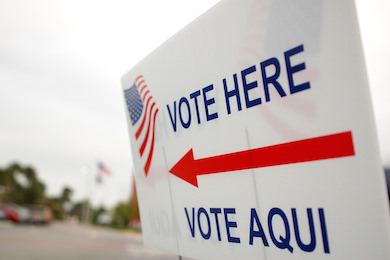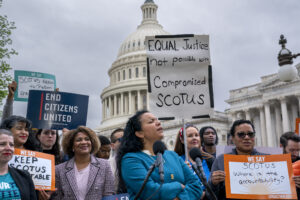Supreme Court Rules That States May Count All Residents in Drawing Election Districts
The justices unanimously uphold the principle of "one person, one vote," but not all of them agree fully with the opinion of colleague Ruth Bader Ginsburg. Voting in the 2016 election is under great scrutiny. (Erik (HASH) Hersman / CC BY-SA 2.0)
Voting in the 2016 election is under great scrutiny. (Erik (HASH) Hersman / CC BY-SA 2.0)
In the midst of a heated election season, Democrats may have won a minor victory—thanks to the Supreme Court.
On Monday, the court released its decision in Evenwel v. Abbott, unanimously allowing states to determine voting districts based on total population figures. The Supreme Court upheld a decades-old American ideal known as “one person, one vote” when it ruled against the plaintiffs, two Texas voters represented by the Project on Fair Representation.
While the court ruled that total population-based apportionment was constitutional, however, it did not mandate that states must draw their districts in this way. According to The Atlantic, the “decision did not address whether states could use voter-eligible apportionment when drawing legislative districts, only ruling that states were not required to do so.”
This case has political and practical implications and may shift voting outcomes across the nation. The distribution of voting districts holds political weight because many people who are ineligible to vote, and therefore are not registered to vote, are undocumented immigrants.
The Project on Fair Representation is a small organization that supports “litigation that challenges racial and ethnic classifications and preferences in state and federal courts.”
The court’s ruling against the project is, as The New York Times sums it up, a ruling that “mostly helped Democrats.”
And although the court ruled unanimously, not all eight judges agreed with Justice Ruth Bader Ginsburg’s opinion. According to SCOTUSblog, Justice Samuel Alito and Justice Clarence Thomas each wrote a separate opinion because they were “not satisfied with the rhetoric and some of the implications” of Ginsburg. SCOTUSblog writes:
While virtually every argument used by the Ginsburg opinion in favor of basing representation on total population (because elected officials supposedly represent everybody and not just the voters) points toward a constitutional mandate, it turns out that the states actually are not bound by the Constitution to craft new election districts by starting with total population. …
The ruling’s bottom line was unanimous, but the main opinion bore many signs that its warm embrace of the theory of equality of representation had to be qualified by leaving the states with at least the appearance of the power of choice, in order to hold together six solid votes.
As Ginsburg expressed hope that the court would decide future apportionment cases, Justice Thomas issued a caution. He writes in his opinion:
The Constitution does not prescribe any one basis for apportionment within States. It instead leaves States significant leeway in apportioning their own districts to equalize total population, to equalize eligible voters, or to promote any other principle consistent with a republican form of government. The majority should recognize the futility of choosing only one of these options. The Constitution leaves the choice to the people alone—not to this Court.
This ruling is a win for liberals, but more conflict over legislative apportionment may be on the horizon.
—Posted by Emma Niles
Your support matters…Independent journalism is under threat and overshadowed by heavily funded mainstream media.
You can help level the playing field. Become a member.
Your tax-deductible contribution keeps us digging beneath the headlines to give you thought-provoking, investigative reporting and analysis that unearths what's really happening- without compromise.
Give today to support our courageous, independent journalists.






You need to be a supporter to comment.
There are currently no responses to this article.
Be the first to respond.